The ASRock X99 Extreme11 Review: Eighteen SATA Ports with Haswell-E
by Ian Cutress on March 11, 2015 8:00 AM EST- Posted in
- Motherboards
- Storage
- ASRock
- X99
- LGA2011-3
CPU Performance
Readers of our motherboard review section will have noted the trend in modern motherboards to implement a form of MultiCore Enhancement / Acceleration / Turbo (read our report here) on their motherboards. This does several things, including better benchmark results at stock settings (not entirely needed if overclocking is an end-user goal) at the expense of heat and temperature. It also gives in essence an automatic overclock which may be against what the user wants. Our testing methodology is ‘out-of-the-box’, with the latest public BIOS installed and XMP enabled, and thus subject to the whims of this feature. It is ultimately up to the motherboard manufacturer to take this risk – and manufacturers taking risks in the setup is something they do on every product (think C-state settings, USB priority, DPC Latency / monitoring priority, memory subtimings at JEDEC). Processor speed change is part of that risk, and ultimately if no overclocking is planned, some motherboards will affect how fast that shiny new processor goes and can be an important factor in the system build.
For reference, the X99 Extreme11 does implement MultiCore Turbo on the M1.01A BIOS we used.
Point Calculations – 3D Movement Algorithm Test: link
3DPM is a self-penned benchmark, taking basic 3D movement algorithms used in Brownian Motion simulations and testing them for speed. High floating point performance, MHz and IPC wins in the single thread version, whereas the multithread version has to handle the threads and loves more cores. For a brief explanation of the platform agnostic coding behind this benchmark, see my forum post here.
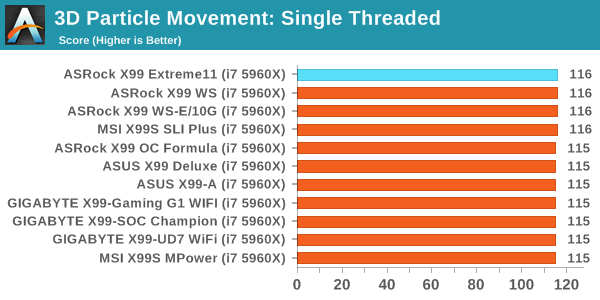
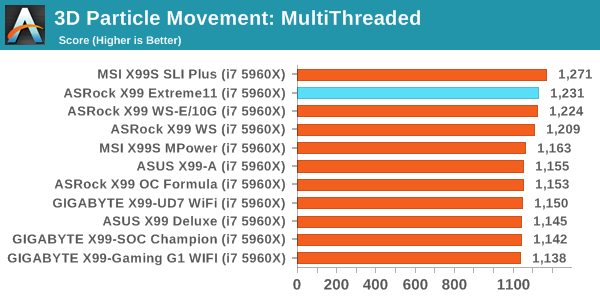
Compression – WinRAR 5.0.1: link
Our WinRAR test from 2013 is updated to the latest version of WinRAR at the start of 2014. We compress a set of 2867 files across 320 folders totaling 1.52 GB in size – 95% of these files are small typical website files, and the rest (90% of the size) are small 30 second 720p videos.
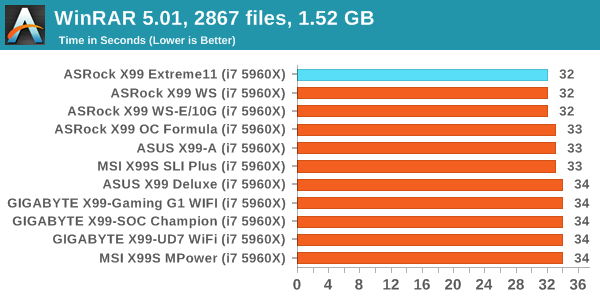
Image Manipulation – FastStone Image Viewer 4.9: link
Similarly to WinRAR, the FastStone test us updated for 2014 to the latest version. FastStone is the program I use to perform quick or bulk actions on images, such as resizing, adjusting for color and cropping. In our test we take a series of 170 images in various sizes and formats and convert them all into 640x480 .gif files, maintaining the aspect ratio. FastStone does not use multithreading for this test, and thus single threaded performance is often the winner.
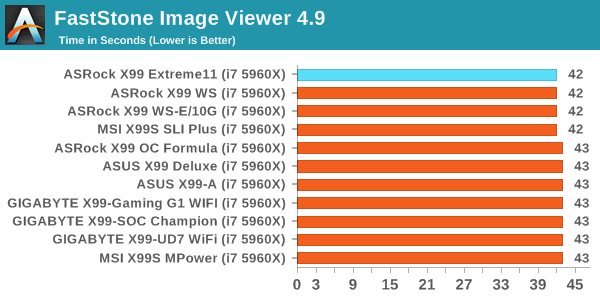
Video Conversion – Handbrake v0.9.9: link
Handbrake is a media conversion tool that was initially designed to help DVD ISOs and Video CDs into more common video formats. The principle today is still the same, primarily as an output for H.264 + AAC/MP3 audio within an MKV container. In our test we use the same videos as in the Xilisoft test, and results are given in frames per second.


Rendering – PovRay 3.7: link
The Persistence of Vision RayTracer, or PovRay, is a freeware package for as the name suggests, ray tracing. It is a pure renderer, rather than modeling software, but the latest beta version contains a handy benchmark for stressing all processing threads on a platform. We have been using this test in motherboard reviews to test memory stability at various CPU speeds to good effect – if it passes the test, the IMC in the CPU is stable for a given CPU speed. As a CPU test, it runs for approximately 2-3 minutes on high end platforms.
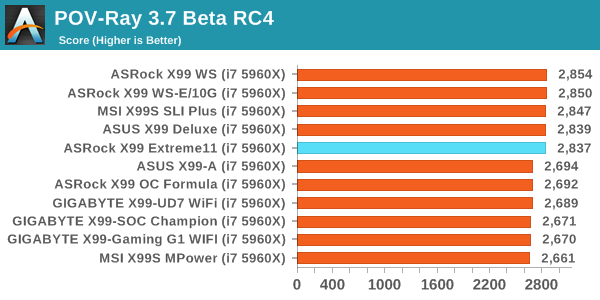
Synthetic – 7-Zip 9.2: link
As an open source compression tool, 7-Zip is a popular tool for making sets of files easier to handle and transfer. The software offers up its own benchmark, to which we report the result.
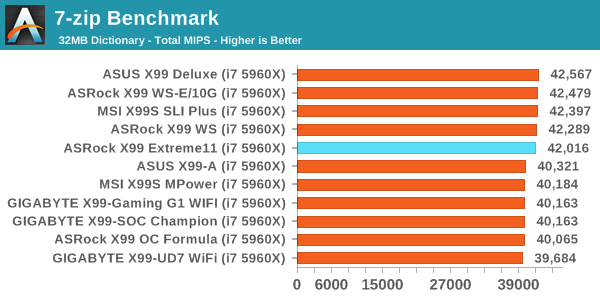










58 Comments
View All Comments
wyewye - Friday, March 13, 2015 - link
"this system is just a confused jumble of parts slapped together"This is the best conclusion for this mobo.
I think they hope marketing/sales guys will be able to bamboozle dummies to sell this as a 18 port raid server mobo. Anyone who spends 600$ on a high-end mobo without reading a review, deserves whats coming to them.
swaaye - Wednesday, March 11, 2015 - link
That chipset fan is cheesy. They most definitely could have come up with a better cooling solution.Hairs_ - Wednesday, March 11, 2015 - link
As pointed out above, this board doesn't answer a single question any user is asking, and it doesn't fulfill any logical useage case.I'm struggling to see why it was reviewed other than the possible reason "reviewer only wants to review weird expensive stuff". Getting in a board whose supposed only reason to exist is the number of storage ports, then not yet the storage, and say " in sure it's the same as the one I reviewed a few years ago " is... Troubling. What was the point of getting it in for review at all??
ClockHound - Wednesday, March 11, 2015 - link
What's the point?It's the new Anandtech, where the point is clicks! Catchy headlines with dubious content, it's how Purch is improving a once great review site. Thanks, Purch!
ap90033 - Friday, March 13, 2015 - link
I think you may be on to something! Sad to see..Stylex - Wednesday, March 11, 2015 - link
I don't understand how motherboards still have usb2 ports. Did it seriously take this long for it to transition from usb1.1 to usb2?DanNeely - Wednesday, March 11, 2015 - link
At the USB1.1-2.0 transition time, Intel chipsets had at most 6 ports; and since the new standard didn't need any more IO pins so they could cut over all at once. Not needing any more IO pins is important because it's been the the limiting factor for chipset cost for a number of years; with the die size being determined by the number of output pins added.The bottleneck for USB3 has been the chipsets. Pre-IVB they had no USB3. IVB added support for 4 ports, haswell bumped it to 6, the 9x series chipsets that were supported to launch with broadwell were essentially unchanged from the previous model. As a result, mobo makers who wanted to add more USB3 have had to spend extra money on 3rd party chips to do so. Initially it was on USB3 controllers which generally ate a PCIe lane for every pair of ports added. More recent designs are using 4 port USB hub chips; which give better bang for the buck but still drive prices up.
When skylake launches later this year, the situation should improve; its higher end versions will offer up to 10 ports. That might be enough ports to make all USB3 configurations possible in the mid range without either using a very small total number of ports or driving the board price up with extra controller chips. High end boards will probably still have some ports attached to a controller though, because Intel's expanding it's use of flexible IO ports and native USB3 will be competing with PCIe storage for IO pins. In both cases though, I suspect a number of boards will also expose the 4 remaining 2.0 ports; probably 1 internal header and 2 external ports. That won't be just a case of 'gotta use them all'; older OSes (eg win7) without native support for USB3 are easier to install if you've got a few 2.0 ports available; and there will be residual demand for 2.0 headers from people with older cases or internal card readers.
The situation is similar with AMD chipsets. But due to their being only able to compete in the value segment of the market, they're behind Intel; topping out at 4 native USB3 ports.
Stylex - Friday, March 13, 2015 - link
Ah, the pin count makes a lot of sense, thanks for that insight!But still, how much more could it possibly drive up the price to use a third party controller, $5-10? I'd pay that for all usb3, especially on a board like this one.
DanNeely - Sunday, March 15, 2015 - link
Estimates I've seen over the last few years put a 2 port USB3-PCIe controller as adding $10 to the retail price of a board; a 4 port USB3 hub chip added $5. The caveats are that hubs only add ports not total bandwidth; which is fine if you're only interested in being able to plug a USB3 device into any port but use sufficiently few of them that sticking multiple high speed devices on the same hub isn't a problem. Controllers don't have that problem; but do need PCIe lanes. Those tend to be in short supply on intels 8x/9x chipsets. Using a 4-8 lane PLX on the chipset relieves that pressure somewhat but is another $10 or $20 to the board price. The situation there will be better for skylake due to the 100 series chipets having 28 high speed IO lanes instead of only 18; but that's partially counter balanced by m2/SataExpress connections needing several lanes each.The lack of native 3.1 support means that the next generation of mobos will probably go the controller route; not hubs to bump up the port count. With Intel rarely doing any major updates on the Tock versions of the chipset, it will probably be at least 2017 before external USB3 controllers mostly go way.
darkfalz - Thursday, March 12, 2015 - link
You have a keyboard, mouse or gamepad that requires 100 MB/sec bandwidth, do you?